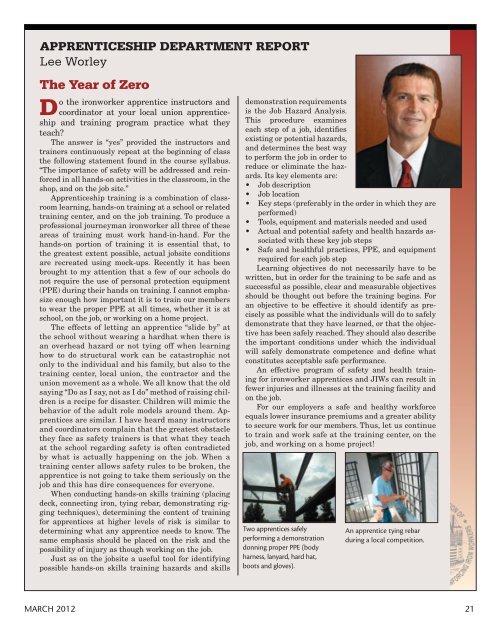2012 Iron Workers/IMPACT North American Labor-Management ...
2012 Iron Workers/IMPACT North American Labor-Management ...
2012 Iron Workers/IMPACT North American Labor-Management ...
You also want an ePaper? Increase the reach of your titles
YUMPU automatically turns print PDFs into web optimized ePapers that Google loves.
APPRENTICESHIP DEPARTmENT REPoRT<br />
Lee Worley<br />
The Year of Zero<br />
Do the ironworker apprentice instructors and<br />
coordinator at your local union apprenticeship<br />
and training program practice what they<br />
teach?<br />
The answer is “yes” provided the instructors and<br />
trainers continuously repeat at the beginning of class<br />
the following statement found in the course syllabus.<br />
“The importance of safety will be addressed and reinforced<br />
in all hands-on activities in the classroom, in the<br />
shop, and on the job site.”<br />
Apprenticeship training is a combination of classroom<br />
learning, hands-on training at a school or related<br />
training center, and on the job training. To produce a<br />
professional journeyman ironworker all three of these<br />
areas of training must work hand-in-hand. For the<br />
hands-on portion of training it is essential that, to<br />
the greatest extent possible, actual jobsite conditions<br />
are recreated using mock-ups. Recently it has been<br />
brought to my attention that a few of our schools do<br />
not require the use of personal protection equipment<br />
(PPE) during their hands on training. I cannot emphasize<br />
enough how important it is to train our members<br />
to wear the proper PPE at all times, whether it is at<br />
school, on the job, or working on a home project.<br />
The effects of letting an apprentice “slide by” at<br />
the school without wearing a hardhat when there is<br />
an overhead hazard or not tying off when learning<br />
how to do structural work can be catastrophic not<br />
only to the individual and his family, but also to the<br />
training center, local union, the contractor and the<br />
union movement as a whole. We all know that the old<br />
saying “Do as I say, not as I do” method of raising children<br />
is a recipe for disaster. Children will mimic the<br />
behavior of the adult role models around them. Apprentices<br />
are similar. I have heard many instructors<br />
and coordinators complain that the greatest obstacle<br />
they face as safety trainers is that what they teach<br />
at the school regarding safety is often contradicted<br />
by what is actually happening on the job. When a<br />
training center allows safety rules to be broken, the<br />
apprentice is not going to take them seriously on the<br />
job and this has dire consequences for everyone.<br />
When conducting hands-on skills training (placing<br />
deck, connecting iron, tying rebar, demonstrating rigging<br />
techniques), determining the content of training<br />
for apprentices at higher levels of risk is similar to<br />
determining what any apprentice needs to know. The<br />
same emphasis should be placed on the risk and the<br />
possibility of injury as though working on the job.<br />
Just as on the jobsite a useful tool for identifying<br />
possible hands-on skills training hazards and skills<br />
demonstration requirements<br />
is the Job Hazard Analysis.<br />
This procedure examines<br />
each step of a job, identifies<br />
existing or potential hazards,<br />
and determines the best way<br />
to perform the job in order to<br />
reduce or eliminate the hazards.<br />
Its key elements are:<br />
• Job description<br />
• Job location<br />
• Key steps (preferably in the order in which they are<br />
performed)<br />
• Tools, equipment and materials needed and used<br />
• Actual and potential safety and health hazards associated<br />
with these key job steps<br />
• Safe and healthful practices, PPE, and equipment<br />
required for each job step<br />
Learning objectives do not necessarily have to be<br />
written, but in order for the training to be safe and as<br />
successful as possible, clear and measurable objectives<br />
should be thought out before the training begins. For<br />
an objective to be effective it should identify as precisely<br />
as possible what the individuals will do to safely<br />
demonstrate that they have learned, or that the objective<br />
has been safely reached. They should also describe<br />
the important conditions under which the individual<br />
will safely demonstrate competence and define what<br />
constitutes acceptable safe performance.<br />
An effective program of safety and health training<br />
for ironworker apprentices and JIWs can result in<br />
fewer injuries and illnesses at the training facility and<br />
on the job.<br />
For our employers a safe and healthy workforce<br />
equals lower insurance premiums and a greater ability<br />
to secure work for our members. Thus, let us continue<br />
to train and work safe at the training center, on the<br />
job, and working on a home project!<br />
Two apprentices safely<br />
performing a demonstration<br />
donning proper PPE (body<br />
harness, lanyard, hard hat,<br />
boots and gloves).<br />
An apprentice tying rebar<br />
during a local competition.<br />
MARCH <strong>2012</strong> 21




